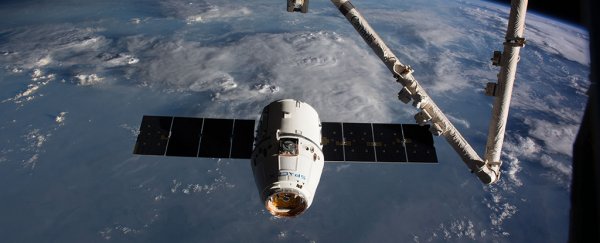Spacecraft manufacturer SpaceX has just launched its 11th commercial supply mission, carrying with it supplies and a bevy of science investigations to the International Space Station.
In a first for SpaceX, the company is reusing a Dragon spacecraft that has already seen action, having flown to the station in 2014 as part of SpaceX's CRS-4 mission.
The veteran Dragon has since been refurbished, fitted with a new heat shield, and deemed fit to fly again. It will now spend two days chasing down the station before arriving on June 5.
Once secured, the crew will begin to unload the 1,700 kilograms of pressurized cargo, while an additional 1,600 kilograms of unpressurised material will be unpacked from Dragon's trunk using the station's robotic arm.
Dragon isn't currently designed to carry human passengers, but there are two special, tiny "crews" on board that will be part of two key studies into heart disease and bone loss.
Nestled in the Dragon's cargo-hold are 6 boxes containing approximately 4,000 fruit flies eggs and 400 adults as part of the Fruit Fly Lab-02 investigation.
Spaceflight is tough on the human body, and in order to better understand the role microgravity plays in heart function, a research team from the Sanford Burnham Research Institute has teamed up with NASA Ames to study how fruit fly hearts function in space.
"One reason is fruit flies share about 75 percent of disease causing genes with humans," explained researcher Karen Ocorr.
The fruit flies will live half their lives – approximately four weeks – on the station before returning to Earth.
Researchers will examine recorded video clips and tissue samples to observe their hearts' functions, and note how they might have been affected by microgravity.
The flies' offspring will also be studied to see how exposure to microgravity affects future generations.
Also on board are 40 mice as part of NASA's latest rodent research experiment, dubbed Rodent Research-5.
This investigation aims to discover how a protein naturally produced by the human body, NELL-1, can aid in bone growth. NASA hopes to grow bone in space to better combat the devastating effects of osteoporosis.
Bone loss, or osteoporosis, affects many people, especially the elderly, as well as astronauts in space, as microgravity increases bone loss.
During the experiment two groups of mice – one in space and one kept on the ground as a control – will receive doses of a treatment called NELL-1 every two weeks.
Following their second round of treatments, 10 mice on the ISS will be randomly selected to return to Earth as part of SpaceX's first live animal return, when all rodents will receive two additional NELL-1 treatments.
Also tucked inside the cargo is equipment for the first ever, space-based investigation into rapidly rotating neutron stars known as pulsars.
Spinning hundreds of times per second, pulsars sweep bright beams of X-ray light across the cosmos like giant lighthouses.
These X-ray emissions can't penetrate Earth's atmosphere, so the Neutron star Interior Composition ExploreR (aka NICER) will measure the precise timing of these pulses from its perch on the space station's exterior.
Scientists hope to one day use the data from NICER to create a galactic GPS, enabling future spacecraft and explorers to navigate the cosmos.
Lastly, a new type of flexible solar panel called a Roll-Out Solar Array (aka ROSA), will unroll like a giant space party favour, unlike current arrays which are rigid and bulky, and unfold like an accordion.
Once unpacked from the trunk, ROSA will be installed on the exterior of the station where it will undergo seven days of testing.
ROSA's creators believe the array's lightweight design will fit a variety of missions and uses, making future spacecraft cheaper.
If the design holds up, models predict this technology could reduce the cost of solar arrays by as much as 25 percent.
That's a lot of awesome science for one tiny vessel that has already gone up and back once.
About 8 minutes after the launch, the Falcon first-stage booster used to launch the cargo vessel was successfully landed at the company's landing pad, Landing Zone 1.
The goal of reusing old equipment is looking good for the future of cheap space travel. To-date, SpaceX has successfully landed six boosters at sea on two floating autonomous drone ships, and now five on land.
Here's to number six, and hopefully many more.
